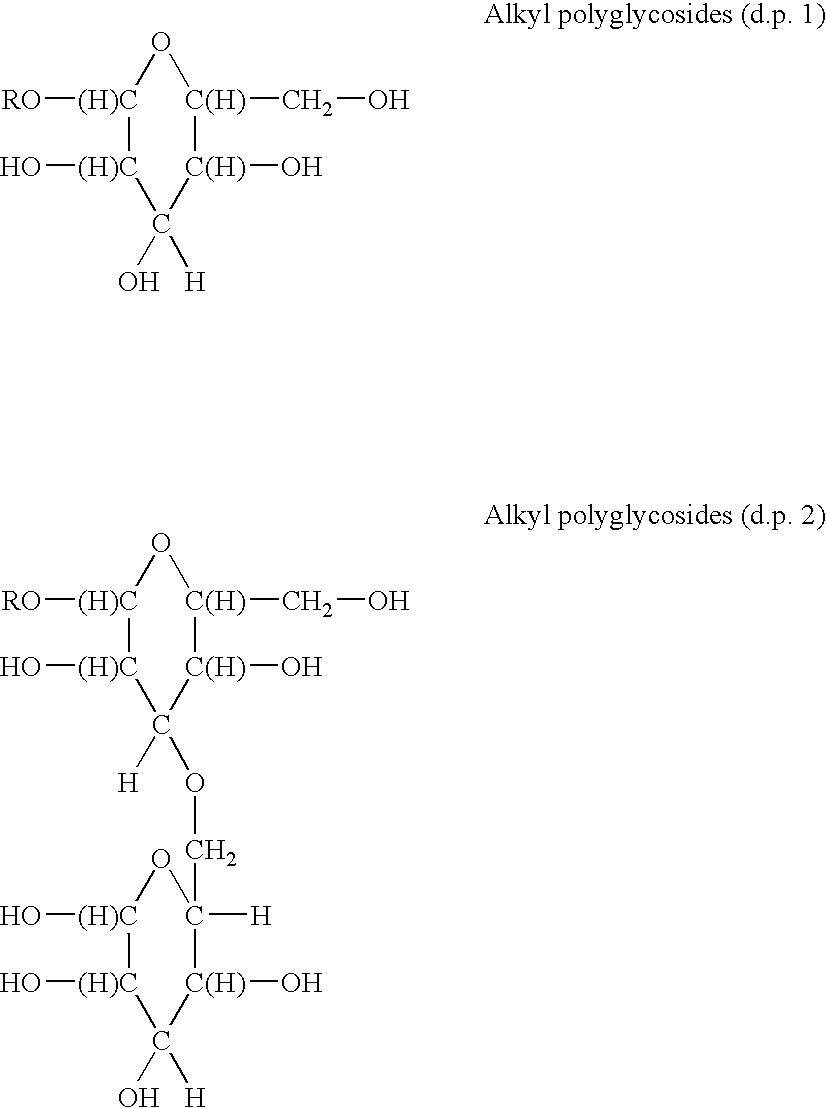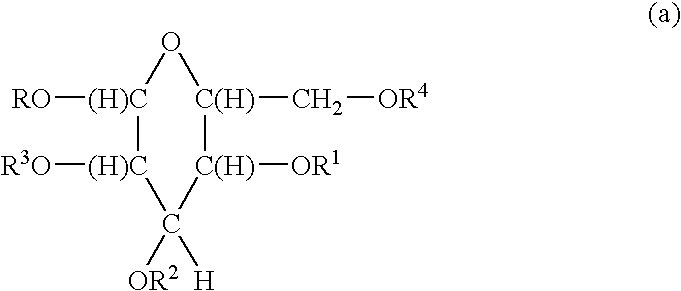Non-ionic surfactants based upon alkyl polyglucoside
a technology of alkyl polyglucoside and surfactants, which is applied in the field of polyglycoside derivatives, can solve the problems of limited water solubility of molecules and products of little commercial interes
- Summary
- Abstract
- Description
- Claims
- Application Information
AI Technical Summary
Benefits of technology
Problems solved by technology
Method used
Image
Examples
embodiment
PREFERRED EMBODIMENT
[0027]In a preferred embodiment R5, R6, R7, R8, R9 R10 and R11 are independently selected from H and
—CH2—CH2—O—(CH2CH2O)a—(CH2CH(CH3)O)b—(CH2CH2O)cH;
with the proviso that R5, R6, R7, R8, R9 R10 and R11 are not all H.
[0028]In a preferred embodiment R5, R6, R7, R8; R9 R10 and R11 are independently selected from H and
with the proviso that R5, R6, R7, R8, R9 R10 and R11 are not all H.
[0029]In a preferred embodiment R1, R2, R3, and R4 are independently selected from H and
—CH2—CH2—O—(CH2CH2O)a—(CH2CH(CH3)O)b—(CH2CH2O)cH;
with the proviso that R1, R2, R3 and R4 are not all H.
[0030]In a preferred embodiment R1, R2, R3, and R4 are independently selected from H and
with the proviso that R1, R2, R3, and R4 are not all H.
[0031]In a preferred embodiment R is alkyl having 8 to 22 carbon atoms.
example 1
[0040]A one-liter, four-necked, round-bottomed flask was equipped through its center neck with an overhead mechanical stirrer, through a second neck with a distillation head fitted with an addition funnel and a condenser / receiver / vacuum take-off assembly, through a third neck fitted with a three hole rubber stopper with a capillary nitrogen bleed, a calibrated mercury thermometer and a vacuum tight temperature controller probe, and on the fourth neck with a septum for sampling.
[0041]The flask was charged with 602.4 g (3.105 moles) of a commercial mixture of C11 to C15 (98% C12 and C13) straight and branched alkanols (Neodol 23 available form Shell Chemical Co.) and 136.6 g (0.69 moles) of a commercially available dextrose monohydrate (Staleydex 333, available from A. E. Staley Mfg. Co. at 9.0% moisture). The slurry was heated at a vacuum of 30 mm Hg (absolute). Water was released starting at about 57 .degree. C. and heating was continued until the slurry had reached 110 .degree. C. ...
examples 2 – 8
Examples 2–8
[0044]The same one-liter, four-necked, round-bottomed flask was equipped through its center neck with an overhead mechanical stirrer, through a second neck with a distillation head fitted with an addition funnel and a condenser / receiver / vacuum take-off assembly, through a third neck fitted with a three hole rubber stopper with a capillary nitrogen bleed, a calibrated mercury thermometer and a vacuum tight temperature controller probe, and on the fourth neck with a septum for sampling.
[0045]The flask was charged with 3.105 moles of the specified alcohol and 136.6 g (0.69 moles) of a commercially available dextrose monohydrate (Staleydex 333, available from A. E. Staley Mfg. Co. at 9.0% moisture). The slurry was heated at a vacuum of 30 mm Hg (absolute). Water was released starting at about 57 .degree. C. and heating was continued until the slurry had reached 110 .degree. C. At this time 3.2 g (0.00345 mole of a commercially available mixture of 50% dinonylnaphthalenesulfo...
PUM
| Property | Measurement | Unit |
|---|---|---|
| total volume | aaaaa | aaaaa |
| NMR mole ratio | aaaaa | aaaaa |
| pressure | aaaaa | aaaaa |
Abstract
Description
Claims
Application Information
 Login to View More
Login to View More - R&D
- Intellectual Property
- Life Sciences
- Materials
- Tech Scout
- Unparalleled Data Quality
- Higher Quality Content
- 60% Fewer Hallucinations
Browse by: Latest US Patents, China's latest patents, Technical Efficacy Thesaurus, Application Domain, Technology Topic, Popular Technical Reports.
© 2025 PatSnap. All rights reserved.Legal|Privacy policy|Modern Slavery Act Transparency Statement|Sitemap|About US| Contact US: help@patsnap.com



